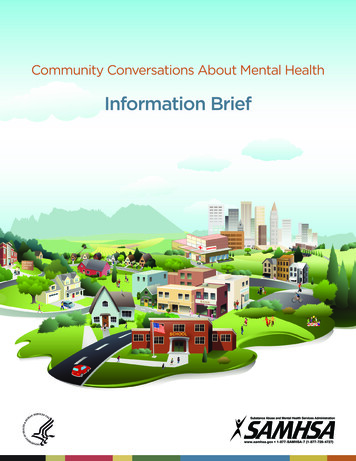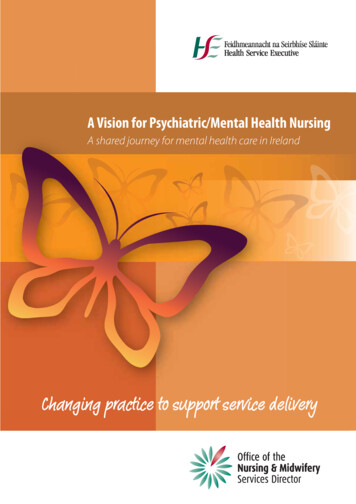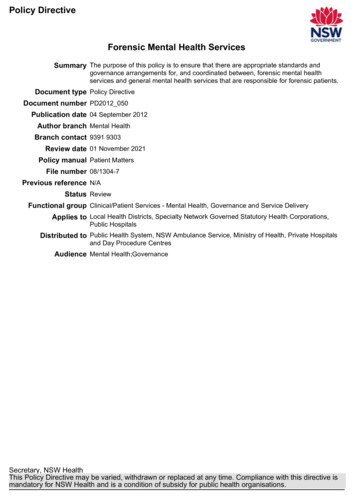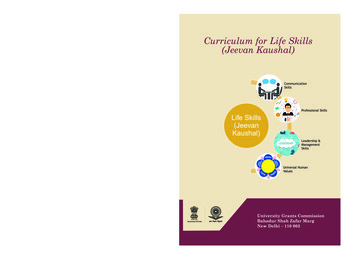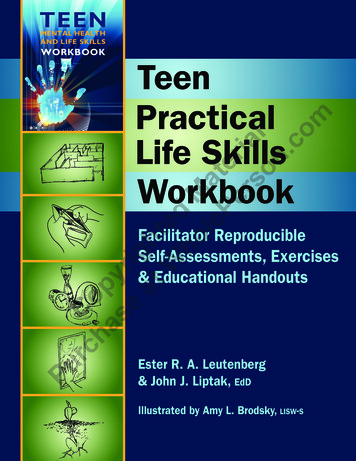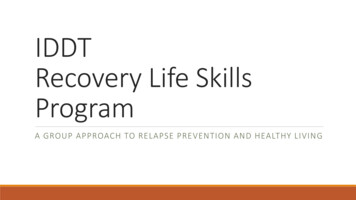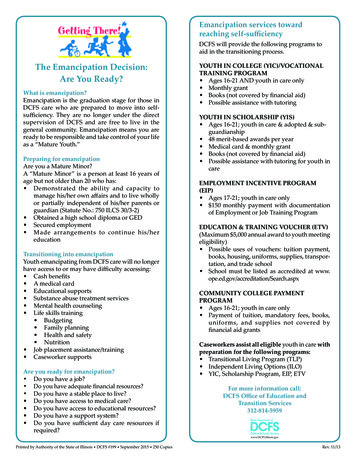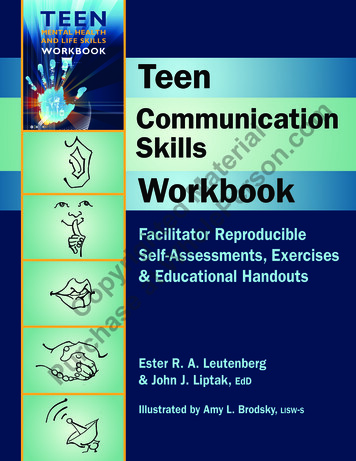
Transcription
TeenMental Healthand Life SkillsWorkbookrc Coha pse yriat ghW tedho Mle atPe errs killsWorkbookWorkbookFacilitator ReproducibleFacilitator ents,Exercises& Educational& EducationalHandouts HandoutsEster A. LeutenbergJohn J. Liptak, EdDPuIllustrated byAmy L. Brodsky, LISW-SEster R. A. Leutenberg& John J. Liptak, EdDIllustrated by Amy L. Brodsky, lisw-sDuluth, Minnesota
rc Coha pse yriat ghW tedho Mle atPe errs ialon.comWhole Person210 West Michigan StreetDuluth, MN leperson.comTeen Communication Skills WorkbookFacilitator Reproducible Self-Assessments,Exercises & Educational HandoutsCopyright 2013 by Ester A. Leutenberg and John J. Liptak.All rights reserved. Except for short excerpts for review purposesand materials in the assessment, journaling activities, andeducational handouts sections, no part of this book may bereproduced or transmitted in any form by any means, electronicor mechanical without permission in writing from the publisher.Self-assessments, exercises, and educational handouts are meantto be photocopied.All efforts have been made to ensure accuracy of the informationcontained in this book as of the date published. The author(s)and the publisher expressly disclaim responsibility for anyadverse effects arising from the use or application of theinformation contained herein.Printed in the United States of America10 9 8 7 6 5 4 3 2 1PuEditorial Director: Carlene SippolaArt Director: Joy Morgan DeyLibrary of Congress Control Number:2012950495ISBN: 978-1-57025-000-0
Using This Book(For the professional)rc Coha pse yriat ghW tedho Mle atPe errs ialon.comInterpersonal communication is the process of sending and receiving messages with another person.It sounds easy, but it is not. For teens, communicating effectively can be a very difficult process. Thereason is that successful communication involves a very complex set of skills, as complex as thosenecessary for driving a car or reading a map. Part of the reason for this complexity is that messagescan be communicated and received in a variety of ways, i.e. listening, speaking, signing, touch, eyecontact. Teens need adequate communication skills in order to survive and thrive in our challengingsociety. Effective communication skills are critical in many walks of life including: Developing and maintaining friendshipsParticipating in the communityDoing well in schoolFunctioning successfully in a group or familyMaintaining and succeeding on a jobRelating well with siblingsMaintaining close relationshipsTeens these days do not have adequate practice at communicating with others because of the use oftexting, social networking, email and instant messaging. Teens rely on impersonal communicationmeans and often lack the skills to engage in face-to-face communication. They may also lack an abilityto read verbal and non-verbal cues and to understand tone.The better the communication skills, the more prepared and successful teens will be. The good news isthat communication skills can be taught, learned and improved through practice. Most teens typicallylearn their communication skills from their family, teachers and friends and thus bad communicationhabits arise when these people are poor role models. When teens do not have good communicationskills, it is important for them to identify their areas of needed improvement and areas for growth,learn better ways of communicating with other people, and find ways to practice critical positive skills.Over the last century, many different workbooks, workshops, and self-help systems have beendesigned to help people explore communication issues and blocks to skillful communication. In thepast twenty years, many research studies have focused on the value of self-reflection and journalingas a way of exploring personal characteristics, identifying weak behaviors, and examining thoughtsand feelings that lead to ineffective behaviors. This book is unique because it combines both powerfulpsychological tools designed to enhance communication skills: self-assessment and journaling.The Teen Communication Skills Workbook contains five separate sections. In each, participants willlearn more about themselves as well as the impact of skillful and non-skillful communicating: Active Listening Scale helps individuals determine how well they listen whencommunicating.Pu Nonverbal Communications Scale helps individuals examine how their body language isaffecting their interpersonal communications. Communications Skills Scale helps individuals measure how accomplished they are atusing communication skills to initiate, build and maintain interpersonal relationships. Cross-Cultural Communication Scale helps individuals explore how well theycommunicate with people who are culturally different. Negotiation Skills Scale helps individuals explore how well they negotiate to get whatthey want without manipulating or alienating other people.(Continued on the next page)
Using This Book (For the professional, continued)rc Coha pse yriat ghW tedho Mle atPe errs ialon.comThese sections serve as avenues for individual self-reflection, as well as group experiences revolvingaround identified topics of importance. Each assessment includes directions for easy administration,scoring and interpretation. In addition, each section includes exploratory activities, reflective journalingactivities and educational handouts to help participants discover their habitual, ineffective methods ofcommunicating with others and to explore new ways for enhancing interpersonal communication.By combining reflective assessment and journaling, participants will be exposed to a powerful methodof communicating. Teens will become more aware of their strengths and areas needing improvementin using these skills.Preparation for using the assessments and activities in this book is important. Theauthors suggest that prior to administering any of the assessments in this book, youcomplete them yourself. This will familiarize you with the format of the assessments, thescoring directions, the interpretation guides and the journaling activities. Although theassessments are designed to be self-administered, scored and interpreted, this familiaritywill help prepare facilitators to answer questions about the assessments for participants.Use Codes for ConfidentialityConfidentiality is a term for any action that preserves the privacy of other people. Because teenscompleting the activities in this workbook might be asked to answer assessment items and to journalabout and explore their relationships, you will need to discuss confidentiality before you begin usingthe materials in this workbook. Maintaining confidentiality is important as it shows respect for othersand allows participants to explore their feelings without hurting anyone’s feelings or fearing gossip,harm or retribution.PuIn order to maintain confidentiality, explain to the participants that they need to assign a name codefor each person they write about as they complete the various activities in the workbook. For example,a friend who they like named Debbie might be titled ILD (I Like Debbie) for a particular exercise. Inorder to protect their friends’ identities, they cannot use people’s actual names or initials, just codes.
The Assessments, Journaling Activitiesand Educational Handoutsrc Coha pse yriat ghW tedho Mle atPe errs ialon.comThe Assessments, Journaling Activities, and Educational Handouts in the Teen Communication SkillsWorkbook are reproducible and ready to be photocopied for participants’ use. Assessments containedin this book focus on self-reported data and can be used by psychologists, counselors, teachers,therapists and career consultants. Accuracy and usefulness of the information provided is dependenton the truthful information that each participant provides through self-examination. By being honest,participants help themselves to learn about unproductive and ineffective patterns, and to uncoverinformation that might be keeping them from being as happy and as successful as they might be.An assessment instrument can provide participants with valuable information about themselves;however, it cannot measure or identify everything about them. The purpose of an assessment isnot to pigeon-hole certain characteristics, but rather to allow participants to explore all of theircharacteristics. This book contains self-assessments, not tests. Tests measure knowledge or whethersomething is right or wrong. For the assessments in this book, there are no right or wrong answers.These assessments ask for personal opinions or attitudes about a topic of importance in theparticipant’s life.When administering assessments in this workbook, remember that the items are generically written sothat they will be applicable to a wide variety of people but will not account for every possible variablefor every person. Use them to help participants identify possible negative themes in their lives and findways to break the hold that these patterns and their effects have.Advise the participants taking the assessments that they should not spend too much time tryingto analyze the content of the questions; their initial response will most likely be true. Regardless ofindividual scores, encourage participants to talk about their findings and their feelings pertaining towhat they have discovered about themselves. Talking about listening, non-verbal communication,cross cultural relationships and negotiations skills can help teens in every aspect of their lives. Thesewellness exercises can be used by group facilitators working with any population who want tostrengthen their overall wellness.A particular score on any assessment does not guarantee a participant’s level of communicationskills. Use discretion when using any of the information or feedback provided in this workbook. Theuse of these assessments should not be substituted for consultation and/or wellness planning with ahealth care professional.PuThanks to the following professionals whose input into this book has been so valuable!Carol Butler, MS Ed, RN, CAnnette Damien, MS, PPSBeth Jennings, CTEC CounselorHannah LavoieJay L. LeutenbergKathy Liptak, Ed.D.Eileen Regen, M.Ed., CJESpecial thanks to Bill Hannes who reminds us that within diversities, people with physicaldisabilities as well as mental health issues are capable, bright and wise in many ways.We just need to take time to be aware of what they offer.
Layout of the BookThe Teen Communication Skills Workbook is designed to be used either independently or as part ofan integrated curriculum. You may administer one of the assessments and the journaling exercisesto an individual or a group with whom you are working, or you may administer a number of theassessments over one or more days.rc Coha pse yriat ghW tedho Mle atPe errs ialon.comThis Book Includes the Following Reproducible Pages in the Five Sections: Assessment Instruments – Self-assessment inventories with scoring directions andinterpretation materials. Group facilitators can choose one or more of the activities relevant totheir participants. Activity Handouts – Practical questions and activities that prompt self-reflection andpromote self-understanding. These questions and activities foster introspection and promotepro-social behaviors. Quotations – Quotations are used in each section to provide insight and promote reflection.Participants will be asked to select one or more of the quotations and journal about what thequotations mean to them. Reflective Questions for Journaling – Self-exploration activities and journaling exercisesspecific to each assessment to enhance self-discovery, learning, and healing. Educational Handouts – Handouts designed to enhance instruction can be used individually orin groups to promote a positive responsibility for communication at home, in the classroom, andin the community. They can be distributed, scanned and converted into masters for overheadsor transparencies, projected or written on boards and/or discussed.Who Should Use This Program?This book has been designed as a practical tool for helping professionals, such as therapists,psychologists, guidance counselors, teachers, group leaders, etc. Depending on the role of theprofessional using the Teen Communication Skills Workbook and the specific group’s needs, thesesections can be used individually or combined for a more comprehensive approach.Why Use Self-Assessments?Self-assessments are important in responding to various teen safety issues because they helpparticipants to: Become aware of the primary motivators that guide their behavior. Explore and learn to “let go” of troublesome habits and behavioral patterns. Explore the effects of unconscious childhood messages.Pu Gain insight and “a wake-up call” for behavioral change. Focus their thinking on behavioral goals for change. Uncover resources they possess that can help them to cope better with communications. Explore their personal characteristics without judgment. Be fully aware of their strengths and weaknesses.Because the assessments are presented in a straightforward and easy-to-use format,individuals can self-administer, score and interpret each assessment at their own pace.
Introduction for the Participantrc Coha pse yriat ghW tedho Mle atPe errs ialon.comYou are going to have many different relationships throughout your life. Some of these relationshipsare with friends, family members, other students in your school, co-workers on your job, and withpeople in your community like your teachers, grocery store clerks, religious leaders, and membersof clubs and organizations to which you belong. As you can see, you will be interacting with somepeople who have similar communication patterns as you, and some who have very different ways ofcommunicating. You will form some of these relationships very easily, but for some, you may have towork. In order to get along and develop relationships with the various people currently in your life andthose you have yet to interact with, you will need a set of communication skills that you can rely on toestablish and maintain effective relationships in your life.Because these relationships are a necessity, not a luxury, you will need to be prepared in order todevelop and maintain these critical relationships. Positive, supportive relationships can help youcope with any difficult times you may encounter, reduce the amount of stress you have, and increaseyour general happiness and life satisfaction. Communication can be described as the center of allinterpersonal relationships. The problem is that communication can be very difficult to initiate,develop and maintain. Managing the dynamics of personal relationships can be quite challenging andcommunication is definitely a skill that takes considerable learning and practice to gain a sense ofmastery. Personal relationships are at times difficult to maintain because they are extremely complex,constantly changing and very fragile. That is why it is beneficial to use effective communication skillsin personal relationships. Effective communication skills ensure that you will listen actively to what theother person is saying, communicate clearly, negotiate to ensure win-win situations, maintain effectivebody language and be aware of the cognitive distortions that may block clear communication betweentwo people.PuThe good news is that if you feel like you are not a good communicator, you can learn and practicethe skills that will help your interpersonal relationships grow in effective ways. This book relies on aself-reflective method that is both therapeutic and fun. The Teen Communication Skills Workbook, isdesigned to help you learn about all the various skills that can be used to enhance or block effectivecommunication between you and other people.
Teen Communication Skills Workbooktable of ContentsSECTION I – Active Listening Scalerc Coha pse yriat ghW tedho Mle atPe errs ialon.comDirections . . . . . . . . . . . . . . . . . . . . . . . . . . . . . . . . . . . . . . . . 13Scale . . . . . . . . . . . . . . . . . . . . . . . . . . . . . . . . . . . . . . . . . 14–15Scoring Directions . . . . . . . . . . . . . . . . . . . . . . . . . . . . . . . . . . . 16Profile Interpretation . . . . . . . . . . . . . . . . . . . . . . . . . . . . . . . . 16Activity HandoutsBuilding Your Listening SkillsWhat Keeps You from Listening Actively – Daydreaming . . .What Keeps You from Listening Actively – Rehearsing . . . . .What Keeps You from Listening Actively – Filtering . . . . . . .What Keeps You from Listening Actively – Judging . . . . . . .What Keeps You from Listening Actively – Distractions . . . .Developing Active Listening SkillsParaphrasing . . . . . . . . . . . . . . . . . . . . . . . . . . . . . . . . . . . .Reflections of Feelings . . . . . . . . . . . . . . . . . . . . . . . . . . . . .Clarification . . . . . . . . . . . . . . . . . . . . . . . . . . . . . . . . . . . . .Open-Ended Questions . . . . . . . . . . . . . . . . . . . . . . . . . . . .Body Language . . . . . . . . . . . . . . . . . . . . . . . . . . . . . . . . . . . .17181920212223242526JournalingListening Strengths and Areas of Growth . . . . . . . . . . . . . . . . . 27Listening and Relationship . . . . . . . . . . . . . . . . . . . . . . . . . . . . 28Quotations about Listening . . . . . . . . . . . . . . . . . . . . . . . . . . . 29Educational Handouts5 Steps of Active Listening . . . . . . . . . . . . . . . . . . . . . . . . . . . . 30Ways to Improve Communication . . . . . . . . . . . . . . . . . . . . . . . 31SECTION II – Nonverbal Communication ScaleDirections . . . . . . . . . . . . . . . . . . . . . . . . . . . . . . . . . . . . . . . . 35Scale . . . . . . . . . . . . . . . . . . . . . . . . . . . . . . . . . . . . . . . . . 36–39Scoring Directions . . . . . . . . . . . . . . . . . . . . . . . . . . . . . . . . . . . 40Profile Interpretation . . . . . . . . . . . . . . . . . . . . . . . . . . . . . . . . 40PuActivity HandoutsExploring Nonverbal CommunicationWith Your Family Members . . . . . . . . . . . . . . . . . . . . . . . . . . 41With Your Friends . . . . . . . . . . . . . . . . . . . . . . . . . . . . . . . . . 42With Members of Your Community . . . . . . . . . . . . . . . . . . . 43With People at School, Volunteer and Work Place . . . . . . . . . 44Tips for Nonverbal Communication . . . . . . . . . . . . . . . . . . . 45Nonverbal Communication Identification . . . . . . . . . . . . . . . 46Nonverbal Communication Log . . . . . . . . . . . . . . . . . . . 47–48
table of ContentsJournaling Activitiesrc Coha pse yriat ghW tedho Mle atPe errs ialon.comNonverbal Communications Pitfalls . . . . . . . . . . . . . . . . . . . . . 49A Communication Quotation . . . . . . . . . . . . . . . . . . . . . . . . . 50Conversation and Nonverbals . . . . . . . . . . . . . . . . . . . . . . . . . 51Educational HandoutsImproving Nonverbal Communication . . . . . . . . . . . . . . . . . . . 52Nonverbal Communication . . . . . . . . . . . . . . . . . . . . . . . . . . . 53SECTION III – Communications Skills ScaleDirections . . . . . . . . . . . . . . . . . . . . . . . . . . . . . . . . . . . . . . . . 57Scale . . . . . . . . . . . . . . . . . . . . . . . . . . . . . . . . . . . . . . . . . 58–59Scoring Directions . . . . . . . . . . . . . . . . . . . . . . . . . . . . . . . . . . . 60Profile Interpretation . . . . . . . . . . . . . . . . . . . . . . . . . . . . . . . . 61Activity HandoutsSending Clear Messages . . . . . . . . . . . . . . . . . . . . . . . . . . . . . 62Emotions . . . . . . . . . . . . . . . . . . . . . . . . . . . . . . . . . . . . . . . . . 63Assertiveness . . . . . . . . . . . . . . . . . . . . . . . . . . . . . . . . . . . 64–65How Has Being Passive Caused Problems for You? . . . . . . . . . 66Passive? Aggressive? Assertive? . . . . . . . . . . . . . . . . . . . . . 67–68Listening . . . . . . . . . . . . . . . . . . . . . . . . . . . . . . . . . . . . . . 69–70Being More Assertive . . . . . . . . . . . . . . . . . . . . . . . . . . . . . . . 71My Communication Goals . . . . . . . . . . . . . . . . . . . . . . . . . . . . 72Social Media . . . . . . . . . . . . . . . . . . . . . . . . . . . . . . . . . . . . . . . 73Journaling ActivitiesA Quote to Think About . . . . . . . . . . . . . . . . . . . . . . . . . . . . . . 74Educational HandoutsCommunication Styles . . . . . . . . . . . . . . . . . . . . . . . . . . . . . . . 75PuSECTION IV – Diversity Communications ScaleDirections . . . . . . . . . . . . . . . . . . . . . . . . . . . . . . . . . . . . . . . . 79Scale . . . . . . . . . . . . . . . . . . . . . . . . . . . . . . . . . . . . . . . . . 80–82Scoring Directions . . . . . . . . . . . . . . . . . . . . . . . . . . . . . . . . . . . 83Profile Interpretation . . . . . . . . . . . . . . . . . . . . . . . . . . . . . . . . 83Scale Descriptions . . . . . . . . . . . . . . . . . . . . . . . . . . . . . . . . . . . 84Activity HandoutsValuing Diversity . . . . . . . . . . . . . . . . . . . . . . . . . . . . . . . . . . . 85Valuing Diversity – My Diverse Friends . . . . . . . . . . . . . . . . . . . 86Valuing Diversity – Who Am I? . . . . . . . . . . . . . . . . . . . . . . . . . 87
table of Contentsrc Coha pse yriat ghW tedho Mle atPe errs ialon.comValuing Diversity – Avoid Stereotyping . . . . . . . . . . . . . . . . . . 88Valuing Diversity – My Stereotypes . . . . . . . . . . . . . . . . . . 89–90Valuing Diversity – Communicating with SomeoneDifferent from Me . . . . . . . . . . . . . . . . . . . . . . . . . . . . . 91–92Empathy . . . . . . . . . . . . . . . . . . . . . . . . . . . . . . . . . . . . . . . 93–94Journaling ActivitiesDiversity Quotations . . . . . . . . . . . . . . . . . . . . . . . . . . . . . . . . 95Educational HandoutsThe Ineffective Communication Cycle . . . . . . . . . . . . . . . . . . . 96Effective Diversity Communication . . . . . . . . . . . . . . . . . . . . . 97SECTION V – Negotiation Style ScaleDirections . . . . . . . . . . . . . . . . . . . . . . . . . . . . . . . . . . . . . . . 101Scale . . . . . . . . . . . . . . . . . . . . . . . . . . . . . . . . . . . . . . . 102–103Scoring Directions . . . . . . . . . . . . . . . . . . . . . . . . . . . . . . . . . . 104Profile Interpretation . . . . . . . . . . . . . . . . . . . . . . . . . . . . . . . 104Activity HandoutsProfile Description – Talker . . . . . . . . . . . . . . . . . . . . . . . . . . 105Profile Description – Steam Roller . . . . . . . . . . . . . . . . . . . . . . 106Profile Description – Preparer . . . . . . . . . . . . . . . . . . . . . . . . . 107Profile Description – Listener . . . . . . . . . . . . . . . . . . . . . . . . . 108Negotiation Situations – Where My Negotiations Occur . . . . . 109Negotiation Situations – When My Negotiations Occur . . . . . . 110Negotiation Process Worksheet . . . . . . . . . . . . . . . . . . . . . . . 111Negotiation Patterns . . . . . . . . . . . . . . . . . . . . . . . . . . . . . . . 112Ideal Negotiations . . . . . . . . . . . . . . . . . . . . . . . . . . . . . . 113-114Journaling ActivitiesPuNegotiation Quotation . . . . . . . . . . . . . . . . . . . . . . . . . . . . . . 115Being a Better Negotiator . . . . . . . . . . . . . . . . . . . . . . . . . . . . 116Learned Attributes of Negotiation . . . . . . . . . . . . . . . . . . . . . . 116Educational HandoutsPrinciples of Successful Negotiation . . . . . . . . . . . . . . . . . . . 117Debating vs. Negotiating . . . . . . . . . . . . . . . . . . . . . . . . . . . . 118Four Negotiations Styles . . . . . . . . . . . . . . . . . . . . . . . . . . . . 119
Section I:rc Coha pse yriat ghW tedho Mle atPe errs ialon.comActive ListeningScalePuNameDate 2013 Whole Person Associates, 210 West Michigan St., Duluth MN 55802-1908 800-247-678911
rc Coha pse yriat ghW tedho Mle atPe errs ialon.comPu12 2013 Whole Person Associates, 210 West Michigan St., Duluth MN 55802-1908 800-247-6789
Section I: active listening scaleActive Listening Directionsrc Coha pse yriat ghW tedho Mle atPe errs ialon.comActive listening is a critical piece of any conversation you have with your friends, family,teachers, and anyone else with whom you talk. The Active Listening Scale was designed tohelp you examine how effective you are in identifying, assessing and overcoming blocks tolistening.This scale consists of two parts; each contains 32 statements.ACTIVE LISTENING I – You will think about a person with whom you believeYOU DO NOT COMMUNICATE well.ACTIVE LISTENING II – You will think about a person with whom you believeYOU DO COMMUNICATE well.Read each of the statements and decide whether or not the statement describes you.If the statement describes you, circle the number next to that item under the TRUE column.If the statement does not describe you, circle the number next to that item under theFALSE column.In the following example from the Active Listening I scale, the circled number under FALSEindicates the statement is not true of the person completing the inventory.Name a person with whom you believe you DO NOT communicate well.(use name code) MJKWhen I am communicating with this person . . .TRUEFALSE1PuI try to understand what the other person is trying to say . . . . . . . . . . . . . . . . . 2This is not a test and there are no right or wrong answers. Do not spend too much timethinking about your answers. Your initial response will likely be the most true for you.Be sure to respond to every statement.(Turn to the next page and begin) 2013 Whole Person Associates, 210 West Michigan St., Duluth MN 55802-1908 800-247-678913
Section I: active listening scaleActive Listening Scale IName a person with whom you believe you DO NOT communicate well.(use name code)When I am communicating with this person . . .Purc Coha pse yriat ghW tedho Mle atPe errs ialon.comTRUE FALSE1. I try to understand what the other person is trying to say . . . . . . . . . . . . . . . 212. I am constantly comparing myself to this person . . . . . . . . . . . . . . . . . . . . . 123. I try to read this person’s mind . . . . . . . . . . . . . . . . . . . . . . . . . . . . . . . . . . . 124. I put aside my judgments of this person . . . . . . . . . . . . . . . . . . . . . . . . . . . 215. I listen for feelings as well as what is being said . . . . . . . . . . . . . . . . . . . . . 216. I ask for clarification if I do not understand something . . . . . . . . . . . . . . . . 217. I usually disagree with this person . . . . . . . . . . . . . . . . . . . . . . . . . . . . . . . . 128. I agree with what this person says, even if I don’t . . . . . . . . . . . . . . . . . . . . 129. I go on and on to prove I am right . . . . . . . . . . . . . . . . . . . . . . . . . . . . . . . . 1210. I make appropriate eye contact . . . . . . . . . . . . . . . . . . . . . . . . . . . . . . . . . . . 2111. I hear only what I want to hear . . . . . . . . . . . . . . . . . . . . . . . . . . . . . . . . . . . 1212. I plan my response while this person is talking . . . . . . . . . . . . . . . . . . . . . . . 1213. I often repeat what this person says . . . . . . . . . . . . . . . . . . . . . . . . . . . . . . . 2114. I listen with my full attention . . . . . . . . . . . . . . . . . . . . . . . . . . . . . . . . . . . . 2115. I do not concern myself about this person’s feelings . . . . . . . . . . . . . . . . . . . 1216. I often find myself lying . . . . . . . . . . . . . . . . . . . . . . . . . . . . . . . . . . . . . . . . 1217. I attempt to understand the meaning of the words being said . . . . . . . . . . . 2118. I finish this person’s sentences . . . . . . . . . . . . . . . . . . . . . . . . . . . . . . . . . . . 1219. I think about other things while this person is talking . . . . . . . . . . . . . . . . . 1220. I jump in and give advice before this person stops talking . . . . . . . . . . . . . . 1221. I make jokes or mock the person talking . . . . . . . . . . . . . . . . . . . . . . . . . . . 1222. I ask questions to get further information . . . . . . . . . . . . . . . . . . . . . . . . . . . 2123. I judge this person ahead of time . . . . . . . . . . . . . . . . . . . . . . . . . . . . . . . . 1224. I reassure and support this person . . . . . . . . . . . . . . . . . . . . . . . . . . . . . . . . 2125. I try to solve this person’s problems for him/her . . . . . . . . . . . . . . . . . . . . . 1226. I am easily distracted . . . . . . . . . . . . . . . . . . . . . . . . . . . . . . . . . . . . . . . . . . . 1227. I focus on specific points and shut out the rest of the message . . . . . . . . . . 1228. I notice this person’s body language and tone of voice . . . . . . . . . . . . . . . . 2129. I find myself daydreaming . . . . . . . . . . . . . . . . . . . . . . . . . . . . . . . . . . . . . . . 1230. I always seem to understand this person’s position clearly . . . . . . . . . . . . . 2131. I often interrupt this person . . . . . . . . . . . . . . . . . . . . . . . . . . . . . . . . . . . . . 1232. I let this person know I heard what was said . . . . . . . . . . . . . . . . . . . . . . . . 21TOTAL (Continued on the next page)14 2013 Whole Person Associates, 210 West Michigan St., Duluth MN 55802-1908 800-247-6789
Section I: active listening scaleActive Listening Scale IIName a person with whom you believe you DO communicate well.(use name code)When I am communicating with this person . . .Purc Coha pse yriat ghW tedho Mle atPe errs ialon.comTRUE FALSE1. I try to understand what the other person is trying to say . . . . . . . . . . . . . . . 212. I am constantly comparing myself to this person . . . . . . . . . . . . . . . . . . . . . 123. I try to read this person’s mind . . . . . . . . . . . . . . . . . . . . . . . . . . . . . . . . . . . 124. I pu
contained in this book as of the date published. The author(s) and the publisher expressly disclaim responsibility for any adverse effects arising from the use or application of the information contained herein. Printed in the United States of America 10 9 8 7 6 5 4 3 2 1 Editorial Director: Carl


